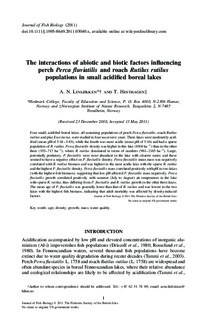The interactions of abiotic and biotic factors influencing perch Perca fluviatilis and roach Rutilus rutilus populations in small acidified boreal lakes
Journal article, Peer reviewed
Permanent lenke
http://hdl.handle.net/11250/134340Utgivelsesdato
2011Metadata
Vis full innførselSamlinger
Originalversjon
10.1111/j.1095-8649.2011.03040.xSammendrag
Four small, acidified boreal lakes, all sustaining populations of perch Perca fluviatilis, roach Rutilus rutilus and pike Esox lucius, were studied in four successive years. Three lakes were moderately acidified (mean pH of 5·61–5·83), while the fourth was more acidic (mean pH of 5·16) and had a sparse population of R. rutilus. Perca fluviatilis density was higher in this lake (1004 ha−1) than in the other three (355–717 ha−1), where R. rutilus dominated in terms of numbers (981–2185 ha−1). Large, potentially predatory, P. fluviatilis were most abundant in the lake with clearest water, and these seemed to have a negative effect on P. fluviatilis density. Perca fluviatilis mean mass was negatively correlated with R. rutilus biomass and was highest in the most acidic lake with the sparse R. rutilus and the highest P. fluviatilis density. Perca fluviatilis mass correlated positively with pH in two lakes (with the highest fish biomass), suggesting that low pH affected P. fluviatilis mass negatively. Perca fluviatilis growth correlated positively with summer (July to August) air temperature in the lake with sparse R. rutilus, thus differing from P. fluviatilis and R. rutilus growth in the other three lakes. The mean age of P. fluviatilis was generally lower than that of R. rutilus and was lowest in the two lakes with the highest fish biomass, indicating that adult mortality was affected by density-induced factors.
